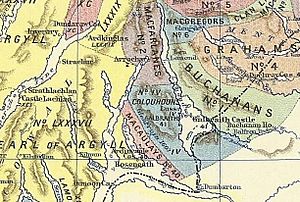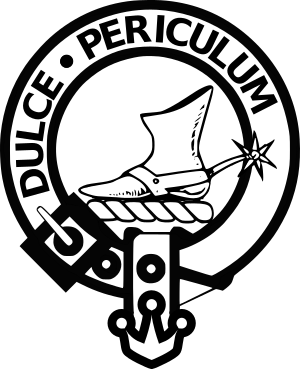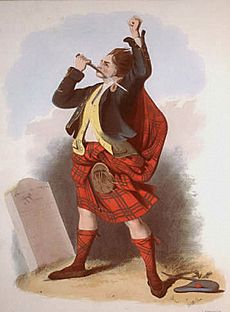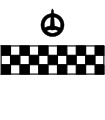Aulay MacAulay of Ardincaple facts for kids
Quick facts for kids
Sir Aulay MacAulay of Ardincaple
|
|
|---|---|

|
|
| Born | 16th century |
| Died | December 1617 |
| Known for | Chief of Clan MacAulay |
| Title | Laird of Ardincaple |
| Successor | Alexander MacAulay of Ardincaple (a first cousin) |
| Spouse(s) |
|
| Children | no children |
| Parent(s) | Walter MacAulay of Ardincaple Margaret Drummond |
Sir Aulay MacAulay of Ardincaple (died 1617) was an important Scottish leader. He was a laird (landowner), a knight, and the chief of his clan, the Clan MacAulay. He also served as a commissioner for his area, representing it in official meetings.
Aulay was the son of Walter MacAulay of Ardincaple, who was also a laird and clan chief. The MacAulay family lands were located where the modern villages of Rhu and Helensburgh are today. These places are on the eastern shore of the Gare Loch in Argyll and Bute, Scotland. As the clan chief, Sir Aulay made an agreement with the chief of the MacGregors, promising to help them. He also had conflicts with other clans, including the Buchanans, Galbraiths, and Campbells. The Campbells even tried to harm him several times, and he was injured in one of these fights. Towards the end of his life, he was made a knight for his service. When he died, his first cousin took over as chief.
Contents
About Sir Aulay MacAulay
Aulay MacAulay was born in the 16th century. He was the son and heir of Walter MacAulay, the laird of Ardincaple and chief of Clan MacAulay. Historians believe that Walter and his older half-brother, Alexander, were likely the first in their family to use the surname MacAulay. Aulay's mother was Margaret Drummond, the eldest daughter of Alexander Drummond of Carnock.
Sir Aulay MacAulay of Ardincaple was married twice. His first wife was Joanna Cunningham. Later, he married Margaret Crawford before April 24, 1592. Margaret was from the Crawford family of Kilbirnie. She was also the widow of James Galbraith of Culcreuch, who was the 16th chief of Clan Galbraith. This marriage caused problems between Sir Aulay and his new stepson, Robert Galbraith, who was the 17th chief of Clan Galbraith.
Chief of Clan MacAulay
After his father passed away, Ardincaple became the chief of Clan MacAulay. The clan's main base was Ardincaple Castle. This castle was built by Aulay's father. The Ardincaple lands are now the villages of Rhu and Helensburgh in Argyll and Bute. This area was part of the Lennox, which was controlled by the Dukes of Lennox. In a list from 1587, Ardincaple was named as one of the Duke of Lennox's most important tenants.

Agreement with Clan Gregor
In the 15th and 16th centuries, clans in the Lennox area often fought and raided each other's lands. These included the MacAulays, MacFarlanes, and Colquhouns. Other clans like the MacGregors, Campbells, and Buchanans also moved into the area.
On May 27, 1591, Ardincaple and Alexander MacGregor of Glenstrae, the chief of Clan Gregor, signed an agreement called a manrent. In this agreement, Ardincaple recognized Glenstrae as his chief. He also promised to pay Glenstrae his calp. Calp was a payment, usually cattle, given to a superior lord or chief in Gaelic society. This agreement helped the MacGregors for a short time against the Buchanans and Galbraiths. At this time, the MacAulays were also having conflicts with the Buchanans.
Historians note that before this agreement, Ardincaple didn't seem to be involved with Clan Gregor. It's not clear how this alliance would benefit his own clan. Some believed that any connection with the MacGregors would lead to trouble, which it eventually did.

Conflicts with Clan Galbraith
In 1593, Robert Galbraith of Culcreuch was given special permission to go after the outlawed Clan Gregor. However, the MacAulays and Colquhouns were suspicious. They thought Culcreuch only wanted to use this permission to attack them, not the MacGregors. They believed Culcreuch was allied with the Buchanans and would use the excuse of hunting MacGregors to get revenge on the MacAulays and Colquhouns.
The chiefs of the MacAulays and Colquhouns complained to the Privy Council (a group of royal advisors). Thanks to the influence of Ardincaple's powerful supporter, Ludovic Stewart, 2nd Duke of Lennox, the special permission was taken away from the Galbraiths and Buchanans. The Privy Council then asked Ardincaple to promise he would not help Clan Gregor.
Conflicts with Clan Campbell
Archibald Campbell, 7th Earl of Argyll had a strong conflict with Ardincaple in the late 1500s and early 1600s. Argyll's leaders in the area, Duncan Campbell and Neil Campbell, led raids into Ardincaple's lands. They tried to kill the MacAulay chief. The Campbells of Carrick lived at Carrick Castle, about 15 kilometers (9 miles) northwest of Ardincaple.
In 1598, Carrick promised to pay a large sum of money if his men harmed Ardincaple. The next year, the Duke of Lennox legally removed some Campbells from lands near the Gare Loch. In response, the Campbells of Carrick and Drongie attacked the Duke's new lands. They gathered at Rosneath and damaged the area. When this was brought to the Privy Council in 1600, both Campbell of Carrick and Campbell of Drongie were declared rebels.
On November 25, 1600, evidence was shown to the Privy Council about an attempt to kill Ardincaple. This happened on September 24, 1600. Carrick's men attacked Ardincaple's followers at night, killing one man. A second attempt on Ardincaple's life happened when he was staying at Nether Greenock. Ardincaple and two of his servants were shot. Again, the Privy Council declared Carrick and his men rebels.
In late November 1600, Carrick and 100 of his followers attacked Ardincaple's lands. They hid in the woods, took prisoners, and damaged houses. They also harmed animals and stole livestock from the Duke's tenants. For these actions, the Campbells were again declared rebels.
Suspicions of Helping Clan Gregor
After the Battle of Glen Fruin in February 1603, the MacGregors were widely disliked. The Privy Council made it illegal to use the name MacGregor or to help anyone from that clan. The Earl of Argyll was tasked with enforcing this law against the MacGregors. Because he was suspicious of Ardincaple's past dealings with the MacGregors, Argyll immediately took action against Ardincaple.
On March 17, 1603, Ardincaple was ordered to appear in Edinburgh. He faced charges of helping the outlawed Alasdair MacGregor of Glenstrae and other MacGregors. He was also accused of not chasing the clan out of the Lennox. Ardincaple was accused of bringing the MacGregor "thieves and rebels" to the Colquhoun lands and helping them steal from the Colquhouns.
Again, the influence of the Duke of Lennox saved Ardincaple. On April 7, 1603, King James VI declared Ardincaple innocent. The king wanted Ardincaple to travel with him to England. By the time the king's letter arrived, Ardincaple had already left the Lennox area with the Duke of Lennox. They were accompanying King James VI on his journey to England, where he would become King James I of England.
Alasdair MacGregor of Glenstrae was finally caught in January 1604. He was brought to Edinburgh for trial. Glenstrae made a statement, which was used against him. In his statement, Glenstrae claimed that Argyll had tried to convince him to kill Ardincaple. Glenstrae said he refused because of a promise he had made to Ardincaple. Glenstrae and several of his men were then executed.
Despite Ardincaple's earlier promise to Glenstrae, historians note that once Clan Gregor was outlawed, Ardincaple turned against them. He became very active in opposing the clan. This was likely to avoid suspicion on himself because of his previous connections with them.
Later Life and Knighthood

In 1597, Ardincaple acted as a guarantor for Lachlan Maclean of Coll. Lachlan had to give up Breachacha Castle when the king demanded it. Sir Aulay was made a knight before 1610. In 1608, he served as a Commissioner for Dumbartonshire. He was one of two commissioners tasked with setting prices for boots and shoes.
In 1614, Angus Og MacDonald of Dunyvaig took Dunyvaig Castle, which belonged to the Bishop of the Isles. Sir Aulay MacAulay of Ardincaple, with twenty of his men, went with the bishop to Islay to demand the castle's surrender. Sir Aulay MacAulay of Ardincaple died in December 1617. He did not have any children with either of his two wives. His first cousin, Alexander MacAulay, took over as chief after him.
Family Heraldry
No official coat of arms for a MacAulay chief has ever been registered with the Lord Lyon King of Arms. This is the official authority for heraldry in Scotland. However, Aulay MacAulay of Ardincaple's seal from 1593 shows a design. It has a checkered band across the middle and a buckle at the top. These symbols are still used in the heraldry of MacAulays today. Historians believe these symbols originally came from the Stewarts.
See Also
- Clan MacAulay, his clan
Images for kids
|
Sir Aulay MacAulay of Ardincaple
Died: December 1617 |
||
| Preceded by Walter MacAulay of Ardincaple |
Chief of Clan MacAulay –1617 |
Succeeded by Alexander MacAulay of Ardincaple |







